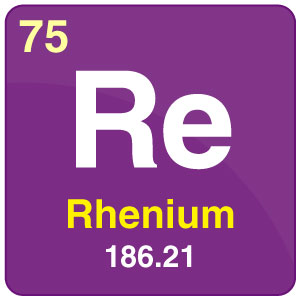Rhenium

| Symbol | Re |
| Atomic Number | 75 |
| Atomic Mass | 186.21 g.mol -1 |
| Discovered by | Walter Noddack, Ida Tacke and Otto Berg in 1925 |

Chemical Properties of Rhenium
| Group | 7 | Melting point | 3185°C, 5765°F, 3458 K |
| Period | 6 | Boiling point | 5590°C, 10094°F, 5863 K |
| Block | d | Density (g cm−3) | 20.8 |
| Atomic number | 75 | Relative atomic mass | 186.21 |
| State at 20°C | Solid | Key isotopes | 187Re |
| Electron configuration | [Xe]4f14 5d5 6s2 |
What is Rhenium?
- The two most important uses of rhenium have been in high-temperature superalloys turbine blades for aircraft engines and platinum-rhenium catalysts.
- It is a heavy, silvery-white and third-row transition metal in group 7 of the periodic table.
- The element can be traced on the earth’s surface in parts per billion.
- The element has no mineral characteristic and it has been detected in certain ores of platinum and molybdenite.
Uses of Rhenium
- The element is mainly used as a petroleum reforming catalyst and also in the turbine engine of high-temperature components as superalloys.
- The element amplifies the high-temperature strength properties of some nickel-based superalloys.
- Rhenium is added to molybdenum and tungsten to form alloys that are used for making filaments for lamps and ovens.
- Rhenium is added to high-temperature superalloys which are used to make jet engine parts.
Properties of Rhenium
- The element has a very high melting point next to Tungsten.
- The element is formed using oxidising smelter residues gained by molybdenite processing.
- The atmospheric heat would be more than sufficient to form the metallic version of this element.
Facts about Rhenium
- The element is an important part of photoflash in photography.
- It is used in the hydrogenation of fine chemicals and also as an additive to molybdenum and tungsten-based alloys.

Comments